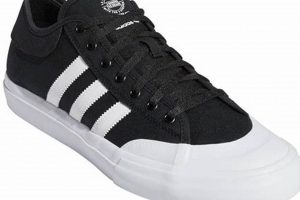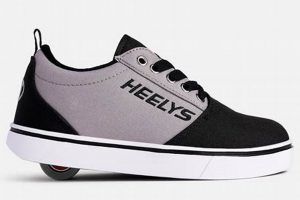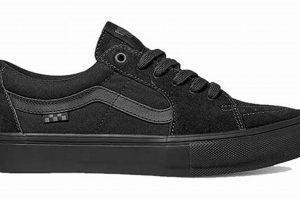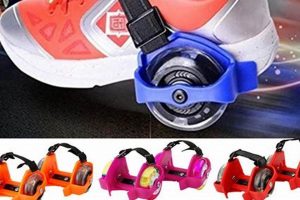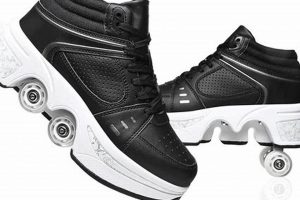Footwear designed specifically for skateboarding, typically constructed to withstand the rigors of the sport while providing support and grip, is commonly available in sizes and styles suitable for younger individuals. These specialized shoes often incorporate features such as reinforced stitching, durable outsoles, and cushioned insoles to enhance performance and protect the wearer’s feet. An example would be a low-profile shoe with a vulcanized rubber sole, commonly used for performing tricks and maneuvers on a skateboard.
The proper footwear is crucial for safety and performance in skateboarding. Durable construction withstands abrasive surfaces and repeated impact, while specialized sole patterns provide enhanced grip on the board. These features can contribute to improved control, stability, and reduced risk of injury. The evolution of skate-specific footwear has paralleled the growth and development of the sport itself, with innovations driven by the needs and demands of skateboarders.
Understanding the design considerations and functional attributes of this type of footwear is essential for selecting the appropriate model. Factors such as material composition, construction techniques, and intended use cases are key determinants. Subsequent sections will elaborate on specific features, materials, and considerations for selecting the optimal footwear based on individual needs and skill level.
Selection Guidance for Skateboarding Footwear
Selecting appropriate footwear for skateboarding is critical for performance, safety, and longevity of the equipment. The following guidelines offer insights into key considerations when choosing skateboarding shoes intended for younger users.
Tip 1: Prioritize Durability: Skateboarding places considerable stress on footwear. Reinforced stitching, particularly in high-wear areas like the toe and ollie patch, is essential. Examine the quality of the materials used; suede or leather uppers generally offer superior abrasion resistance compared to canvas.
Tip 2: Evaluate Sole Construction: Vulcanized soles, known for their flexibility and board feel, are a common choice. Cupsole construction provides greater impact protection but may sacrifice some board feel. Consider the skateboarding style when selecting sole construction; street skating often benefits from vulcanized soles, while park skating may warrant the added protection of cupsoles.
Tip 3: Assess Ankle Support: High-top shoes provide increased ankle support, which can be beneficial for beginners or those with a history of ankle injuries. Low-top shoes offer greater flexibility and freedom of movement, preferred by many experienced skateboarders.
Tip 4: Ensure Proper Fit: A snug, but not constricting, fit is crucial. Ensure adequate toe room to prevent discomfort during prolonged use. Consider that skate shoes may stretch slightly over time, particularly those made of suede or leather.
Tip 5: Inspect Tread Pattern: A grippy tread pattern is essential for maintaining control on the skateboard. Look for patterns that offer a balance of grip and flexibility. The specific pattern may vary depending on the brand and model.
Tip 6: Consider Insole Cushioning: Adequate insole cushioning absorbs impact and reduces foot fatigue. Look for insoles that offer good arch support and shock absorption. Replacement insoles can be purchased to customize the level of cushioning and support.
Tip 7: Research Brand Reputation: Established skateboarding shoe brands typically have a proven track record of producing durable and high-performing footwear. Read reviews and seek recommendations from experienced skateboarders to inform the decision-making process.
Adhering to these guidelines increases the likelihood of selecting skateboarding footwear that provides adequate protection, support, and performance. The right choice contributes significantly to a safer and more enjoyable skateboarding experience.
The following sections will address common issues encountered during skateboarding and offer maintenance strategies to prolong the life of the footwear.
1. Durability
Durability represents a critical attribute in skateboarding footwear intended for younger users, given the demanding nature of the sport and the increased potential for wear and tear. The structural integrity of the footwear directly impacts safety, performance, and the overall lifespan of the product.
- Material Selection and Abrasion Resistance
The materials used in the construction of skateboarding shoes significantly influence their resistance to abrasion. Suede and leather, known for their robust properties, are commonly employed in high-wear areas such as the toe cap and ollie patch. These materials withstand the repetitive friction against the skateboard deck and rough surfaces, mitigating premature degradation. Conversely, less durable materials like canvas may exhibit accelerated wear, compromising the shoe’s structural integrity and requiring more frequent replacement. The selection of appropriate materials is therefore a primary factor in enhancing longevity.
- Reinforced Stitching and Construction Techniques
The manner in which the shoe components are assembled plays a crucial role in overall durability. Reinforced stitching, particularly in stress-bearing zones, prevents seam failure and delamination. Double or triple stitching techniques enhance the connection between the upper, sole, and other critical elements, fortifying the shoe against the forces exerted during skateboarding maneuvers. Box-stitched ollie pads are commonly implemented to resist the abrasion from ollies. The implementation of robust construction methods directly translates to extended lifespan and improved performance under demanding conditions.
- Sole Composition and Bond Strength
The outsole material and its bond to the upper are paramount for long-term durability. Vulcanized rubber soles, known for their flexibility and grip, must be securely bonded to the upper to prevent separation. Cupsole designs, offering enhanced impact protection, require similarly strong adhesion. The composition of the rubber itself influences its resistance to abrasion and tearing. High-quality rubber compounds, engineered for skateboarding applications, exhibit superior resilience and contribute to a more durable and reliable sole structure. The integrity of the sole directly affects board feel, grip, and overall shoe performance.
- Internal Reinforcements and Structural Support
Internal reinforcements, such as supportive heel counters and reinforced toe boxes, provide additional structural integrity and protect the foot from impact and abrasion. These features maintain the shoe’s shape, prevent excessive stretching or deformation, and enhance overall support. Heel counters stabilize the heel and ankle, reducing the risk of injury during high-impact landings. Reinforced toe boxes protect the toes from direct impact with the skateboard or other surfaces. The incorporation of these internal reinforcements contributes to a more durable and protective skateboarding shoe.
The combination of high-quality materials, robust construction techniques, durable sole compositions, and internal reinforcements determines the overall durability of skateboarding footwear. For younger skateboarders, prioritizing these aspects is critical for ensuring a safe, comfortable, and long-lasting product capable of withstanding the rigors of the sport.
2. Grip
Grip, in the context of skateboarding footwear designed for younger individuals, represents a fundamental performance characteristic dictating control and safety. The coefficient of friction between the shoe’s outsole and the skateboard deck directly influences the rider’s ability to maintain balance, execute maneuvers, and prevent slippage. Inadequate grip can lead to loss of control, increasing the risk of falls and injuries. Specialized rubber compounds and tread patterns are therefore integral components of such footwear, engineered to optimize surface adhesion under the dynamic conditions of skateboarding. For example, a vulcanized sole with a herringbone pattern provides multidirectional grip essential for executing tricks and maintaining stability during landings.
Variations in grip performance can be attributed to differences in rubber durometer, tread depth, and pattern design. Softer rubber compounds generally offer enhanced grip but may exhibit accelerated wear, particularly on abrasive surfaces. Deeper tread patterns channel away debris and water, maintaining contact even in less-than-ideal conditions. Conversely, shallower patterns may provide improved board feel but reduced grip on uneven or wet surfaces. The selection of a grip-optimized outsole directly impacts the skater’s confidence and capability, enabling more consistent and controlled performance. The practical application of this understanding manifests in the skater’s ability to maintain board control during complex maneuvers like ollies, kickflips, and grinds, which require precise foot placement and immediate response.
The significance of grip extends beyond mere performance enhancement, impacting safety and skill progression. Reliable grip minimizes the likelihood of uncontrolled slides and falls, particularly for novice skaters who are still developing their balance and coordination. Moreover, enhanced grip facilitates faster learning and skill acquisition, allowing skaters to focus on refining technique without being hampered by inadequate equipment. Although maintaining optimal grip presents challenges related to material wear and environmental factors, the continuous development of innovative rubber compounds and tread designs underscores the commitment to improving safety and performance in skateboarding footwear. The advancement in grip technology directly contributes to the evolution of the sport and the safety of its participants.
3. Ankle support
Ankle support in footwear designed for skateboarding is a critical feature, particularly in models intended for younger users. The inherent instability of the activity and the potential for missteps necessitate design considerations that mitigate the risk of ankle injuries. The following outlines essential facets of ankle support within the context of skateboarding footwear.
- High-Top vs. Low-Top Design
The height of the shoe collar directly impacts the degree of ankle support provided. High-top designs extend above the ankle joint, offering increased stability and limiting range of motion. This can be beneficial for beginners or individuals with a history of ankle instability. Low-top designs, conversely, offer greater flexibility and freedom of movement, preferred by experienced skateboarders who prioritize board feel. The choice between high-top and low-top designs represents a trade-off between support and maneuverability, influencing the overall suitability of the footwear.
- Internal Heel Counter Reinforcement
The heel counter, a rigid or semi-rigid component located at the rear of the shoe, plays a crucial role in providing lateral stability to the ankle. Reinforced heel counters limit excessive pronation or supination of the foot, reducing the risk of sprains and other injuries. Stiffer materials, such as molded plastic or reinforced leather, offer greater support. The effectiveness of the heel counter depends on its shape, size, and the materials used in its construction. Its proper integration into the shoe’s design ensures optimal ankle stabilization.
- Collar Padding and Support Structures
The padding around the ankle collar enhances comfort and provides additional support. Thicker padding can cushion the ankle against impacts and prevent chafing. Some designs incorporate internal support structures, such as straps or braces, to further limit ankle movement. These structures restrict excessive inversion or eversion, providing a more secure and stable fit. The effectiveness of collar padding and support structures relies on their ergonomic design and the quality of the materials used.
- Lacing Systems and Fit Adjustment
The lacing system contributes significantly to ankle support by securing the foot within the shoe and preventing slippage. A well-designed lacing system allows for precise adjustment, enabling the wearer to customize the level of support. Higher lacing patterns, extending further up the ankle, offer greater stability. Locking eyelets can further enhance support by preventing the laces from loosening during activity. A secure and properly adjusted lacing system is essential for maximizing the benefits of other ankle support features.
The integration of these facets dictates the overall effectiveness of ankle support in skateboarding shoes. The selection of appropriate features should be based on individual needs, skill level, and skating style, prioritizing injury prevention and performance enhancement.
4. Impact absorption
Impact absorption is a crucial performance characteristic of skateboarding footwear, particularly in models designed for younger users who may lack fully developed skeletal systems. The repetitive stress from landings and general use can lead to discomfort or injury. Consequently, appropriate design and material selection become paramount.
- Insole Composition and Density
The insole constitutes a primary component for attenuating impact forces. Materials such as polyurethane (PU) and ethylene-vinyl acetate (EVA), known for their cushioning properties, are frequently employed. Higher density insoles generally provide superior impact resistance, while lower density options offer greater flexibility. The selection of appropriate insole material and density must balance shock absorption with board feel and responsiveness. For example, a thick PU insole can effectively mitigate heel impact but may reduce the skater’s sensitivity to subtle board movements.
- Midsole Integration and Material Properties
The midsole, positioned between the insole and outsole, can contribute significantly to impact absorption. Materials such as Phylon or EVA are often used to create a lightweight and cushioning layer. The thickness and density of the midsole influence its ability to absorb impact. Some designs incorporate specialized cushioning technologies, such as air pockets or gel inserts, to further enhance shock absorption. The integration of a well-designed midsole can noticeably reduce stress on the feet and joints during landings and other high-impact maneuvers. However, a thicker midsole may elevate the skater’s foot further from the board, potentially reducing stability.
- Outsole Construction and Durometer
While primarily responsible for providing grip and durability, the outsole can also contribute to impact absorption. Thicker outsoles made from resilient rubber compounds offer increased cushioning. The durometer, a measure of rubber hardness, affects both grip and impact absorption. Softer rubber compounds tend to provide better grip and shock absorption but may exhibit accelerated wear. Harder compounds are more durable but offer less cushioning. Outsole designs that incorporate flex grooves or segmented patterns can further enhance impact absorption by allowing the sole to compress and deform upon impact.
- Heel Padding and Support Structures
The heel region is particularly vulnerable to impact stress during skateboarding. Enhanced heel padding, often incorporating gel or foam inserts, can effectively attenuate impact forces and reduce the risk of heel bruising or other injuries. Internal support structures, such as reinforced heel counters, provide additional stability and prevent excessive pronation or supination, further minimizing stress on the ankle and foot. The inclusion of robust heel padding and support structures is especially important in footwear designed for younger skateboarders who may be more susceptible to impact-related injuries.
The cumulative effect of these design elements dictates the overall impact absorption capability of skateboarding footwear. Prioritizing appropriate insole and midsole materials, outsole construction, and heel padding enhances comfort, reduces the risk of injury, and promotes sustained performance. These considerations are particularly pertinent when selecting footwear to enhance performance and minimize harm during skateboarding activities.
5. Proper fit
The correct size and fit are paramount when selecting skateboarding footwear for boys. Ill-fitting shoes compromise performance, increase the risk of injury, and detract from the overall skateboarding experience. Attention to specific fit parameters is essential for ensuring both comfort and safety.
- Length and Toe Room
Adequate length is necessary to prevent toe crowding, which can lead to discomfort, blisters, and long-term foot problems. A thumb’s width of space between the longest toe and the end of the shoe is a commonly cited guideline. However, individual foot shapes vary, and some skaters prefer a snugger fit for enhanced board feel. Insufficient toe room may also impair circulation, reducing foot sensitivity and control.
- Width and Arch Support
The shoe’s width must accommodate the wearer’s foot without constricting it. Overly narrow shoes cause discomfort and can exacerbate foot conditions. Conversely, excessively wide shoes allow the foot to slide, reducing stability and control. Arch support, either built-in or provided by an aftermarket insole, is essential for maintaining proper foot alignment and preventing arch pain. The type and level of support should be tailored to the individual’s foot type and needs.
- Heel Hold and Ankle Stability
Proper heel hold prevents slippage during activity, enhancing stability and reducing the risk of ankle injuries. The heel counter, a structural element at the rear of the shoe, should securely cradle the heel without causing friction or pressure points. Inadequate heel hold can lead to blisters and decreased control. The lacing system should allow for a snug, adjustable fit that provides adequate ankle support, particularly in high-top models.
- Material Flexibility and Break-In Period
The flexibility of the shoe’s upper and sole influences comfort and board feel. Stiff materials may require a break-in period to conform to the foot’s shape. Leather and suede uppers typically mold to the foot over time, while synthetic materials may retain their shape. Excessive stiffness can restrict movement and reduce sensitivity. The ideal level of flexibility balances support with freedom of movement, allowing for natural foot articulation.
Selecting skateboarding shoes that meet these fit criteria is crucial for young skaters. A well-fitted shoe not only enhances performance and comfort but also minimizes the risk of injuries, contributing to a more enjoyable and safe skateboarding experience.
Frequently Asked Questions
The following addresses common inquiries regarding skateboarding footwear designed for young individuals. These answers aim to provide clear and concise information for informed decision-making.
Question 1: What constitutes a skateboarding shoe?
Specialized footwear designed to withstand the rigors of skateboarding. Key features include durable construction, reinforced stitching, a flat, grippy sole, and impact-absorbing cushioning. The design prioritizes board feel, control, and protection against abrasion and impact.
Question 2: How does skateboarding footwear differ from athletic shoes?
Skateboarding shoes prioritize durability and grip, whereas athletic shoes often focus on cushioning and flexibility for running or jumping. Skate shoes typically feature a flatter sole with a vulcanized or cupsole construction for enhanced board feel, while athletic shoes often have more aggressive tread patterns and specialized cushioning systems. The reinforcement is prioritized at different wear point.
Question 3: When should a skateboarding shoe be replaced?
Replacement is indicated when the sole loses significant grip, the upper exhibits substantial wear or tearing, or the cushioning becomes compressed and ineffective. Inspect high-wear areas regularly for signs of degradation. Compromised structural integrity compromises both performance and safety.
Question 4: Are certain materials superior for skateboarding shoes?
Suede and leather are commonly used for uppers due to their durability and abrasion resistance. Vulcanized rubber is favored for soles due to its flexibility, grip, and board feel. The specific material selection should align with the skater’s style and the anticipated level of wear.
Question 5: What features provide adequate ankle support?
High-top designs offer greater ankle support than low-top designs. Reinforced heel counters and padded collars contribute to stability and reduce the risk of ankle injuries. The effectiveness of ankle support depends on the overall fit and lacing system.
Question 6: How does sole construction impact skateboarding performance?
Vulcanized soles provide excellent board feel and flexibility, ideal for technical skateboarding. Cupsole construction offers greater impact protection but may sacrifice some board feel. The selection of sole construction should reflect the skater’s style and terrain preferences.
Choosing skateboarding footwear entails assessing durability, grip, support, and fit to ensure optimal performance and protection. Regular inspection and timely replacement are essential for maintaining safety and effectiveness.
Next, the article addresses common problems and maintenance tips for skateboard footwear.
Boys Skate Shoes
The preceding discussion has detailed the critical attributes of footwear designed for young skateboarders. Durability, grip, ankle support, impact absorption, and proper fit have been identified as paramount considerations. The interplay of these elements dictates the performance, safety, and longevity of the equipment. Careful assessment of materials, construction techniques, and design features is necessary to ensure that selected footwear meets the demands of skateboarding activity.
Continued advancements in materials science and footwear technology promise to further enhance the performance and safety of specialized skateboarding shoes. The responsible selection and maintenance of these products represent a commitment to the well-being and skill development of young skateboarders. Further investigation and awareness will help propel the sport and its participants to a new horizon.


